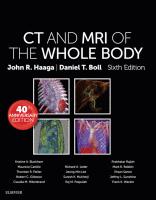Physical Address
304 North Cardinal St.
Dorchester Center, MA 02124

Normal Anatomy Trachea and Main Bronchi The trachea comprises 16 to 22 C -shaped cartilages that are linked longitudinally by annular ligaments of fibrous and connective tissue. The cartilages are connected posteriorly by the membranous wall of the trachea, which…

Normal Anatomy Pleura and Chest Wall The pleura is a thin, two-layered serous membrane that lines the lungs and thoracic cavity. The visceral pleura lines the lungs and invaginates into a double layer to form the major and minor fissures,…

There are many excellent textbooks and articles on the mediastinum. This chapter references these articles and a review of the recent literature as the basis for a discussion of the anatomy, pathology, and radiologic manifestations of mediastinal diseases. Normal Anatomy…

Although most primary pulmonary tumors are carcinomas, a large histologic spectrum of benign and malignant tumors of the lung exist. This chapter reviews the more common neoplasms according to the classification proposed by the World Health Organization (WHO) ( Box…

Although many lung disorders can be diagnosed from the plain chest radiograph, its limitations in providing a definitive diagnosis are widely understood. Complicated chest radiographs, the lack of radiographic abnormalities in symptomatic patients, and the limitations of portable chest studies…

Introduction Development of the spine and spinal cord is a complex process determined by an intricate chain of embryologic stages under precise genetic control. Although congenital abnormalities of spine development are frequently classified according to the specific derangement responsible for…

A variety of systemic diseases affect the osseous skeleton and therefore the spine. Detection of bone abnormalities with imaging can be challenging with plain film, given that demineralization, a common element of many conditions, requires a 50% decrease in bone…

Introduction Spinal vascular diseases consist of spinal vascular malformations, spinal aneurysms, and spinal cord arterial ischemia. They are relatively rare but should be kept in the differential diagnosis for spinal tumors, demyelinations, or compressive myelopathies. As for spinal vascular malformations,…

A broad spectrum of cystic lesions can be identified on spine imaging. Multiple etiologies and different imaging characteristics of these lesions make the differential diagnosis a challenging issue for radiologists. Cysts may develop within the spinal canal and may be…

Introduction Spinal infection is a common disease worldwide and is being recognized more often, especially since the introduction of more sophisticated imaging techniques. It may be a primary disease, starting locally as a spinal infection, or secondary to a systemic…